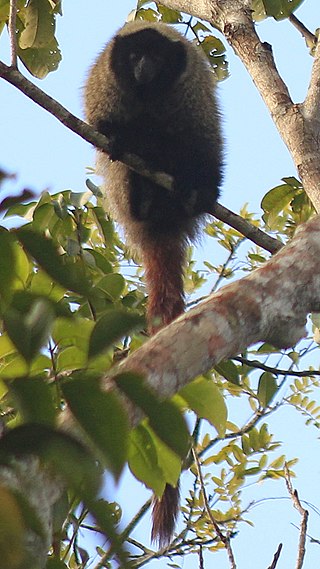
The Pitheciidae are one of the five families of New World monkeys now recognised. Formerly, they were included in the family Atelidae. The family includes the titis, saki monkeys and uakaris. Most species are native to the Amazon region of Brazil, with some being found from Colombia in the north to Bolivia in the south.

The titis, or titi monkeys, are New World monkeys of the subfamily Callicebinae, which contains three extant genera: Cheracebus, Callicebus, and Plecturocebus. This subfamily also contains the extinct genera Miocallicebus, Homunculus, and Carlocebus.

Callicebus is a genus of monkeys known as titi monkeys.

The Madidi titi monkey, also known as the GoldenPalace.com monkey or the golden palace monkey, is a titi, a kind of New World monkey, discovered in western Bolivia's Madidi National Park in 2004. Its scientific name is Plecturocebus aureipalatii, the specific epithet meaning "of the Golden Palace", in reference to GoldenPalace.com, an online casino which paid US$650,000 to have the species named after it, with benefits going toward the nonprofit organization that maintains the park where the titi was discovered.

The black titi monkey, is a species of titi, a type of New World monkey, from South America. It is found in Brazil, Colombia, and Venezuela. It was described in 1811 as Calicebus lugens. It is sometimes called the widow monkey.

The Lucifer titi monkey is a species of titi, a type of New World monkey, from South America. It is found in Brazil, Colombia, Ecuador, and Peru. It was described as Callicebus lucifer in 1914. The Lucifer titi has previously been treated as part of C. torquatus, the collared titi.

The collared titi monkey is a species of titi, a type of New World monkey. It is endemic to northern Brazil.

The Atlantic titi monkey or masked titi is a species of titi, a type of New World monkey, endemic to Brazil.

The black-fronted titi monkey is a species of titi, a type of New World monkey.

The coastal black-handed titi monkey is a species of titi, a type of New World monkey, endemic to Brazil.

The white-eared titi monkey also known as the Bolivian titi or Bolivian gray titi, is a species of titi monkey, a type of New World monkey, from eastern Bolivia and an area of western Brazil. The species has a range that extends east from the Manique River in Beni Department, Bolivia to southern Rondônia in Brazil. The southern end of its range includes forests around the city of Santa Cruz de la Sierra.

Coimbra Filho's titi monkey or just Coimbra's titi is a species of titi, a type of New World monkey, endemic to forests in the Brazilian states of Bahia and Sergipe. It was first discovered by Shuji Kobayashi. It is considered one of the most endangered of all Neotropical primates. It is named after Adelmar F. Coimbra-Filho, founder and Former Director of the Rio de Janeiro Primate Centre, in honor of his work in the field of Brazilian primatology and biology.

The brown titi monkey is a species of titi monkey, a type of New World monkey, from South America. It is endemic to Brazil. It was originally described as Callicebus brunneus in 1842 and transferred to the newly erected genus Plecturocebus in 2016.

Prince Bernhard's titi monkey, also called the zog-zog monkey, is a species of titi monkey in the genus Plecturocebus, first described in 2002. It is named after Prince Bernhard of the Netherlands. They have varying coloration of gray, black, and agouti, with dark orange in certain regions. They are endemic to Brazil, found mostly in disturbed forest environments. While officially listed as least-concern by the International Union for the Conservation of Nature (IUCN), they may, in fact, be at-risk due to human-caused deforestation.

The Colombian black-handed titi monkey is a species of titi, a type of New World monkey, endemic to Colombia. It was originally described in the genus Callicebus in 1963.
Thomas R. Defler is a North American primatologist who lives and works in Colombia.
Milton's titi monkey is a species of titi monkey, a type of New World monkey, from southern Amazon rainforest, Brazil. It was named after the Brazilian primatologist Milton Thiago de Mello. Milton's titi was discovered in 2011 by Julio César Dalponte, and recognized as a new species in 2014.

Plecturocebus is one of three genera of titi monkeys.



















